Excerpts from Jim Conrad's
Naturalist Newsletter
from the June 19, 2016 Newsletter issued from Hacienda Chichen Resort beside Chichén Itzá Ruins; limestone bedrock; elevation ~39m (~128ft), N20.675°, W88.569°; central Yucatán state, MÉXICO
MAKAL/ EDIBLE XANTHOSOMA SAGITTIFOLIUM
Last summer when I lived in the little Maya village of Yaxunah 20 kms south of Chichén Itzá, I saw that many of the town's farmers grew a member of the Arum or Jack-in-the-pulpit Family, the Araceae, which they called Makal. It's very similar to the big Arrowleaf Elephant Ears, Xanthosoma sagittifolium, presently outside my hut door, only very much smaller, and seldom if ever flowering. You can see me standing beneath an Arrowleaf Elephant Ear leaf at www.backyardnature.net/yucatan/elephant.htm
In Yaxunah and elsewhere in the Yucatan, I've not seen the Maya growing large plantings of Makal, but rather they scatter a few plants around their houses or next to their cornfields/milpas, or both places. Everyone knows that Makal tubers are edible, and they're pretty good when cooked, a little like boiled potatos, but nowadays people are gravitating away from such traditional foods, toward Coca-Cola and store-bought food. Makal is considered "poor-folks' food." The Arrowleaf Elephant Ears by my hut don't produce tubers.
Until now I've not commented on Makal in the Newsletter because I've always been unsure exactly what Makal is. For some years I waited to stumble upon a flowering plant -- flowers usually are the key to identification -- but now I'm thinking that Makal just doesn't like to flower, or it can't. The Arrowleaf Elephant Ears outside my hut flower readily, though their ovaries seem to abort and no fruits result. Makal doesn't even seem to try.
A few weeks ago, in mid April when I was in the Lacandon community of Lacanja Chansayab in Chiapas's Lacandon Reserve in extreme southeastern Mexico, I saw what looked like a belly-high Makal growing along a trail, and photographed it. It's shown below:
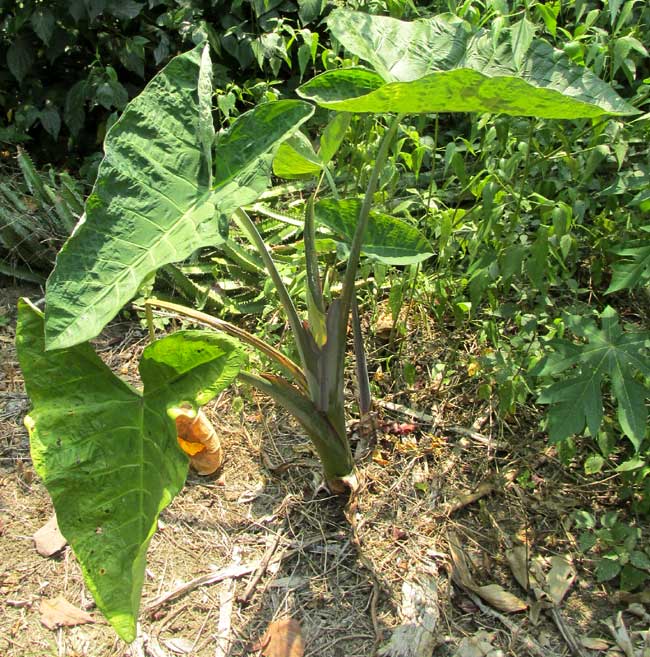
I'm bringing Arrowleaf Elephant Ears into the discussion about Makal because of whats said on an excellent web page on root crops of the Maya, in Spanish, produced by the Autonomous University of Yucatán, UADY, at http://www.mayas.uady.mx/exposiciones/exp_044444.html
There I read that the root crop Kukut Makal, which I'm just calling Makal, is Xanthosoma yucatanense, but that probably that name is just a synonym for Xanthosoma sagittifolium -- which is Arrowleaf Elephant Ears.
So, is the Lacandon plant Makal, and is Makal a cultivated form -- a cultivar -- of Arrowleaf Elephant Ear?
An important field mark separating Arrowleaf Elephant Ears from other look-alike plants is that its leaves' petioles attach to its blades in a certain way, which you can see at www.backyardnature.net/n/11/111120xo.jpg
On the Lacandon plant in Chiapas, the sinus connection is a little different, as shown below:
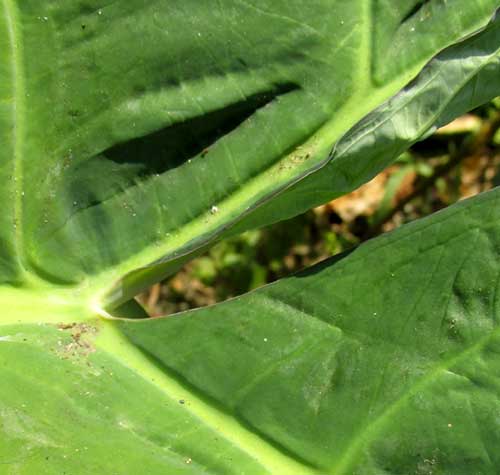
The FAO produces a very informative page on Xanthosoma sagittifolium -- which they call Tannia or Yautia -- at http://www.fao.org/docrep/T0646E/T0646E0o.htm
There it's said that the cultivation of Xanthosoma sagittifolium may have originated in northern South America and spread through the Caribbean area and Central America. When Europeans arrived on the continent, it was already known from southern Mexico to Bolivia. They also write that domestication may have occurred in various places and with different materials, with different goals in mind.
The paper also says that there's enormous variability among the group of Xanthosoma sagittifolium-like edible plants, with some cultivars not assignable to any formally recognized species or cultivar name. Moreover, since seeds are seldom produced, reproduction is almost entirely vegetative. The paper sums up the name situation by saying that in recent years the tendency has been to give the name Xanthosoma sagittifolium -- Arrowleaf Elephantears' name -- to all cultivated clones of Xanthosoma, at least "... until a modern revision of the genus clarifies the taxonomic situation of the species mentioned."
I think that with regard to Makal's "real identity," that's about as far as I can go. The Lacandon plant is larger than Makal seen here in the central Yucatan, but that may be because there's more rainfall and the soil was richer in that part of Chiapas than here.
from the September 14, 2018 Newsletter issued from Rancho Regenesis in the woods ±4kms west of Ek Balam Ruins; elevation ~40m (~130 ft), N~20.876°, W~88.170°; central Yucatán, MÉXICO
A FLOWERING MAKAL
Here at the rancho, Elephant Ear and Makal sometimes have been confused with one another and I also have had a hard time being sure which is which. Over the last year the identities have become clearer to me.
But first, the big Elephant Ear, much planted in tropical gardens for their striking large leaves, often produces attractive flowering structures of the Jack-in-the-pulpit kind, as shown on our ../yucatan/elephant.htm">Elephant Ear page. Until this week I'd believed that the Makal cultivar was always sterile because of the many I've seen none has ever been flowering. Below, you can see that flowering structure, somewhat smaller than on most Elephant Ears:
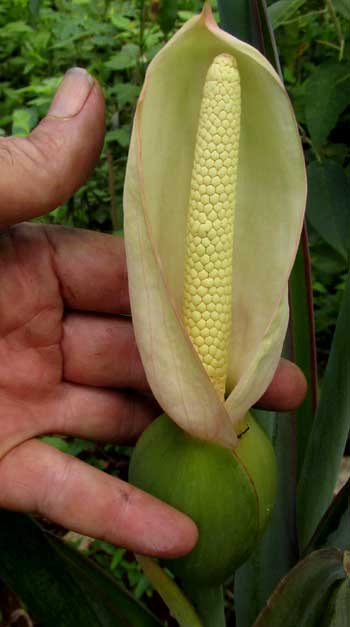
The six-ft-high (3m) Makal bearing the flowering structure is seen below:
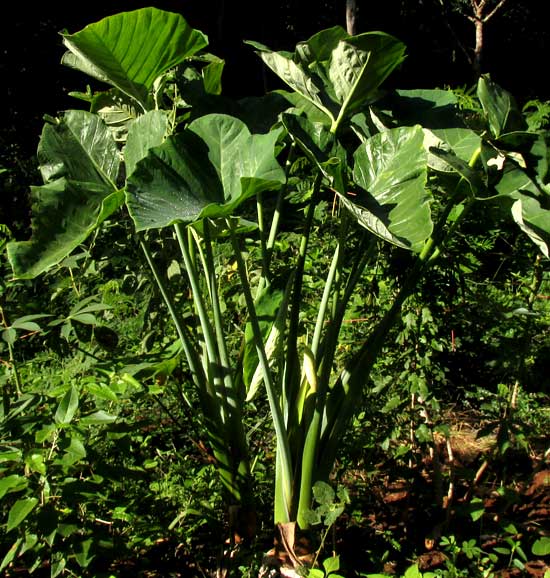
In the flower picture we see a white, fingerlike spike, or "spadix," partially enveloped by a white, hoodlike "spathe." The visible part of the spadix bears hundreds of tiny male flowers. Notice that the spathe constricts near its midsection, enlarging and becoming green below. That part of the spathe loosely envelops the lower part of the spadix, which bears female flowers. Eventually the male-flower-bearing part will wither away while the lower green part will expand and the spathe will be filled with the remaining bottom of the spadix which, if sexual fertilization has taken place, will bear numerous fruits -- like corn on a cob inside its husk. At our plant's bottom, just below the flowering structure there's an old structure from which the spadix has fallen, and the lower part expanded, shown below:
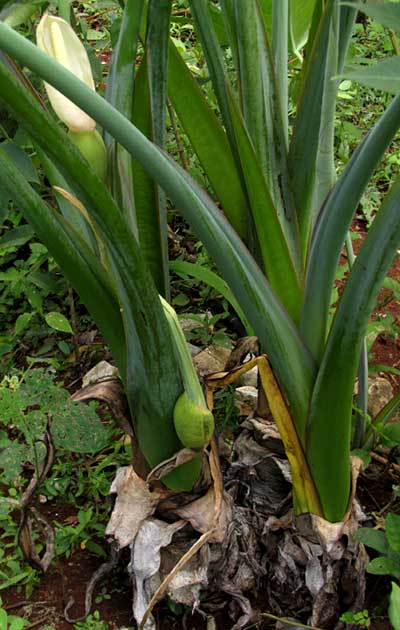
The Maya tell me that what distinguishes Makal from Elephant Ear is that the latter is uniformly light green throughout, while Makal's leaf stems, or petioles, are slightly tinged with purple along their edges. Below, you can see these purplish edges:
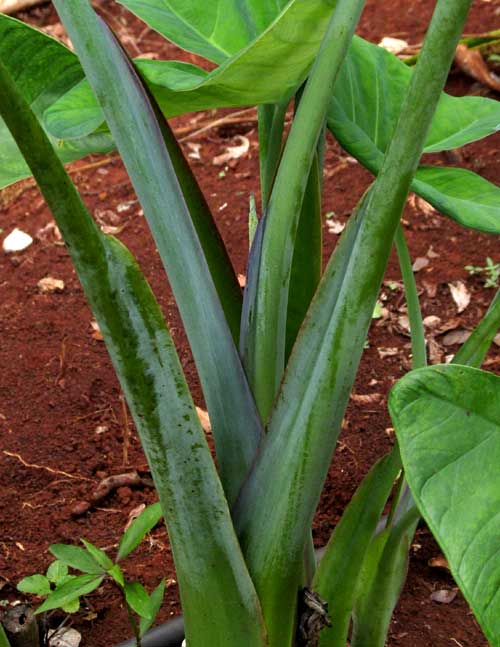
There you also see that the petiole bases also bear a silvery bloom -- they're "glaucous" -- not seen on Elephant Ears.
I hesitated to accept these field marks as certain distinguishing marks for Makal because I thought I'd seen purplishness on certain races of Elephant Ear, but maybe I hadn't. Anyway, on my own I've noticed a difference in leaf shape. The leaves of both Makal and Elephant Ears are deeply lobed at their bases, lending the leaves an arrowhead shape. On Makal the lobes are rounded while on Elephant Ears they're more pointy -- though sometimes leaves with intermediate lobes are see -- as shown below:
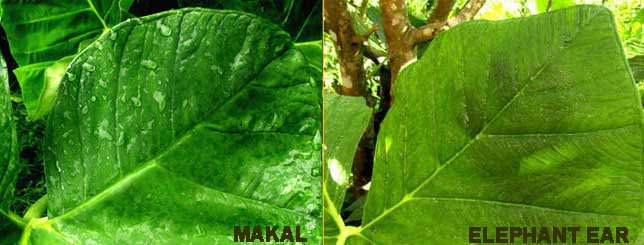
I read that when Europeans arrived in the Americas, Makal already was being eaten by the natives from southern Mexico throughout Central America to Bolivia in South America. Over this large area, domestication from the Elephant Ear may have taken place at various localities, and preparation of the tuberous underground stem always including of roasting and cooking the tubers, to eliminate irritant calcium oxalate crystals and saponins.
Makal, under other names such as Tannia, Yautia and New Cocoyam, is one of two members of the Arum or Jack-in-in-pulpit Family with world importance as an "energy food." The other species, known variously as Taro, Cocoyam, Dasheen and other names -- it's Colocasia esculenta. In some places, especially West Africa, Makal is replacing Taro as the main food, because it produces more. Its tuberous, underground stems contain between 15 and 39% carbohydrates, 2-3% protein, and 70-77% water. This nutritional content is comparable to the potato, and probably the cooked tuber easier to digest. Makal's young leaves also can be eaten, but I've not tried that, having so much Chaya handy.
I'm growing Makal now and hope that in a few months I can show you how it's harvested, prepared and eaten.
from the November 23, 2018 Newsletter issued from Rancho Regenesis in the woods ±4kms west of Ek Balam Ruins; elevation ~40m (~130 ft), N~20.876°, W~88.170°; central Yucatán, MÉXICO
EATING MAKAL LEAVES & STEM
Makal produces an underground starchy tuber that can grow as large as, I'm told here, a soccer ball, maybe as big as a basketball. So far I've only seen them about the size of hen eggs, so I'm waiting for a big one to profile here.
Meanwhile, I'd read that young Makal leaves can be eaten, and that the bottom part of the stem also is edible. This week I needed to remove a Makal that was too close to a Chaya tree with its edible leaves, and tried eating a leaf and part of a stem. Below, you can see a plant's young, unfolding, pale green leaf just right for eating
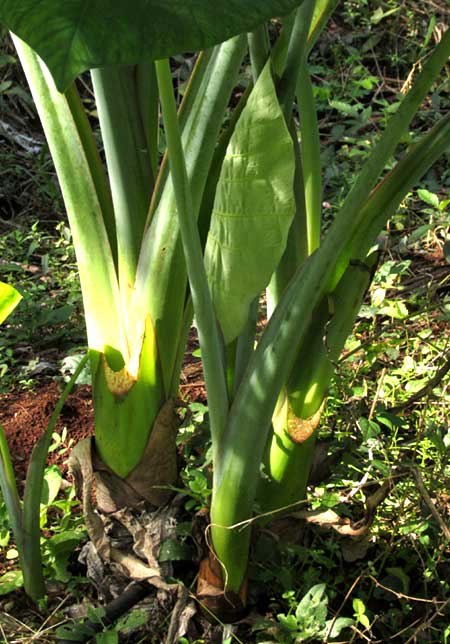
The Makal tuber and presumably other parts of the plant are toxic until cooked, so I hesitated to eat much of the stem. A Maya worker at the ranch told me to just eat that part of the stem immediately above the slender roots, which I did. Below, you can see a bowl of chopped greens resulting from one young leaf, and a plant's lower stem removed for eating:
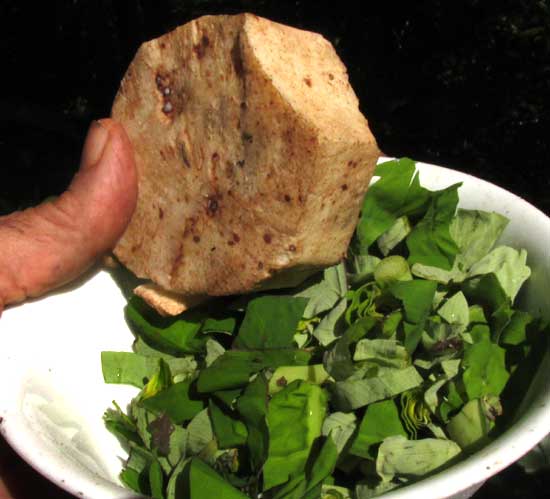
The whitish stem part was sliced into several thin wafers, then fried in a skillet like fried potatoes. In fact, I added onion just as I do with fried potatoes, and the dish tasted like fried potatoes. Once the stem part was singed to a golden hue on both sides, I added the leaf shreds, and once they'd cooked down, ate it all. It was pretty good, nothing spectacular, and probably fried potatoes tastes better to most people, but if the infrastructure has collapsed and you're hungry in the tropics, this might be a good dish to remember.
from the December 7, 2018 Newsletter issued from Rancho Regenesis in the woods ±4kms west of Ek Balam Ruins; elevation ~40m (~130 ft), N~20.876°, W~88.170°; central Yucatán, MÉXICO
EATING MAKAL TUBERS
This week I've eaten the tubers. Gener, one of the Maya workers at the rancho, showed me how his family unearths Makal's tubers. Below, you can see Gener's hands exposing a potato-like tuber beneath a Makal plant:
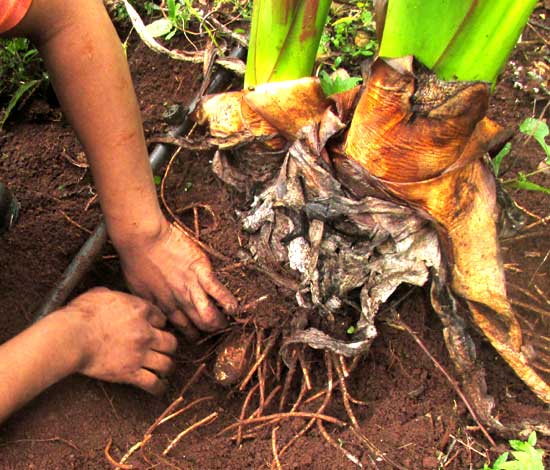
A washed tuber is shown below:
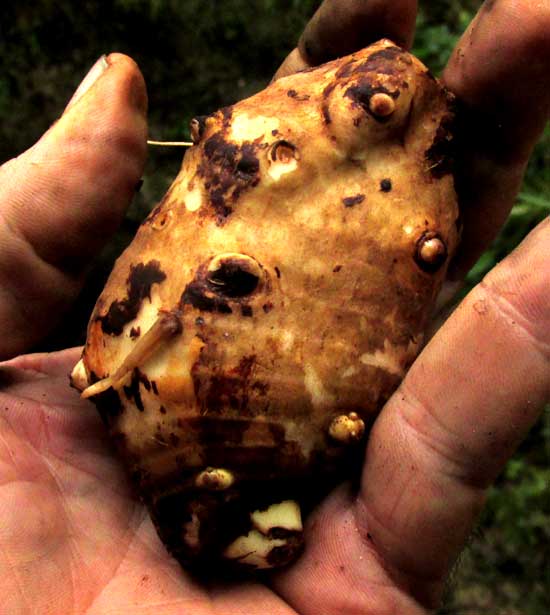
You can see that the tuber, just like a potato, bears "eyes" on its sides. If the tuber is cut into several sections, with each section bearing an eye, the eye will sprout and produce a new plant, also as with potatoes. Sometimes Makal tubers are roasted in fires, or sliced and fried in skillets, or boiled in pots, all as with potatoes. One difference between Makal tubers and potatoes is that Makal tubers are toxic until they're cooked.
I boiled my tubers and found them filling, with their own subtle, homey taste, but not as tasty as potatoes, though that may have been a cultural bias. Each plant, if grown in rich soil and watered regularly, produces several tubers -- enough to make it worthwhile for people to grow them.